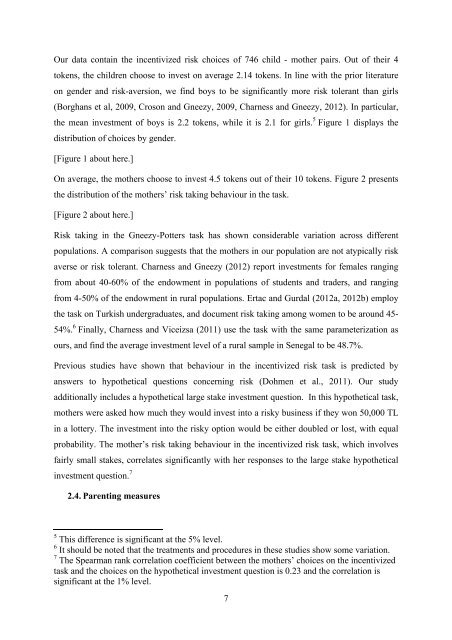Parental socialisation effort and the intergenerational transmission ...
Parental socialisation effort and the intergenerational transmission ...
Parental socialisation effort and the intergenerational transmission ...
- No tags were found...
Create successful ePaper yourself
Turn your PDF publications into a flip-book with our unique Google optimized e-Paper software.
Our data contain <strong>the</strong> incentivized risk choices of 746 child - mo<strong>the</strong>r pairs. Out of <strong>the</strong>ir 4tokens, <strong>the</strong> children choose to invest on average 2.14 tokens. In line with <strong>the</strong> prior literatureon gender <strong>and</strong> risk-aversion, we find boys to be significantly more risk tolerant than girls(Borghans et al, 2009, Croson <strong>and</strong> Gneezy, 2009, Charness <strong>and</strong> Gneezy, 2012). In particular,<strong>the</strong> mean investment of boys is 2.2 tokens, while it is 2.1 for girls. 5 Figure 1 displays <strong>the</strong>distribution of choices by gender.[Figure 1 about here.]On average, <strong>the</strong> mo<strong>the</strong>rs choose to invest 4.5 tokens out of <strong>the</strong>ir 10 tokens. Figure 2 presents<strong>the</strong> distribution of <strong>the</strong> mo<strong>the</strong>rs’ risk taking behaviour in <strong>the</strong> task.[Figure 2 about here.]Risk taking in <strong>the</strong> Gneezy-Potters task has shown considerable variation across differentpopulations. A comparison suggests that <strong>the</strong> mo<strong>the</strong>rs in our population are not atypically riskaverse or risk tolerant. Charness <strong>and</strong> Gneezy (2012) report investments for females rangingfrom about 40-60% of <strong>the</strong> endowment in populations of students <strong>and</strong> traders, <strong>and</strong> rangingfrom 4-50% of <strong>the</strong> endowment in rural populations. Ertac <strong>and</strong> Gurdal (2012a, 2012b) employ<strong>the</strong> task on Turkish undergraduates, <strong>and</strong> document risk taking among women to be around 45-54%. 6 Finally, Charness <strong>and</strong> Viceizsa (2011) use <strong>the</strong> task with <strong>the</strong> same parameterization asours, <strong>and</strong> find <strong>the</strong> average investment level of a rural sample in Senegal to be 48.7%.Previous studies have shown that behaviour in <strong>the</strong> incentivized risk task is predicted byanswers to hypo<strong>the</strong>tical questions concerning risk (Dohmen et al., 2011). Our studyadditionally includes a hypo<strong>the</strong>tical large stake investment question. In this hypo<strong>the</strong>tical task,mo<strong>the</strong>rs were asked how much <strong>the</strong>y would invest into a risky business if <strong>the</strong>y won 50,000 TLin a lottery. The investment into <strong>the</strong> risky option would be ei<strong>the</strong>r doubled or lost, with equalprobability. The mo<strong>the</strong>r’s risk taking behaviour in <strong>the</strong> incentivized risk task, which involvesfairly small stakes, correlates significantly with her responses to <strong>the</strong> large stake hypo<strong>the</strong>ticalinvestment question. 72.4. Parenting measures5 This difference is significant at <strong>the</strong> 5% level.6 It should be noted that <strong>the</strong> treatments <strong>and</strong> procedures in <strong>the</strong>se studies show some variation.7 The Spearman rank correlation coefficient between <strong>the</strong> mo<strong>the</strong>rs’ choices on <strong>the</strong> incentivizedtask <strong>and</strong> <strong>the</strong> choices on <strong>the</strong> hypo<strong>the</strong>tical investment question is 0.23 <strong>and</strong> <strong>the</strong> correlation issignificant at <strong>the</strong> 1% level. 7
















